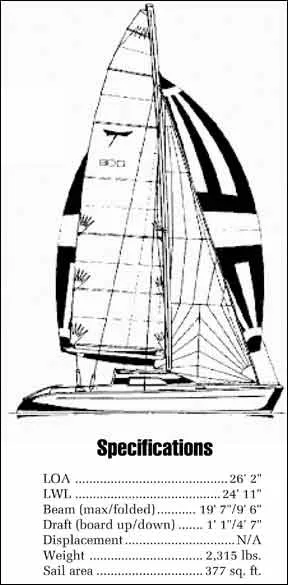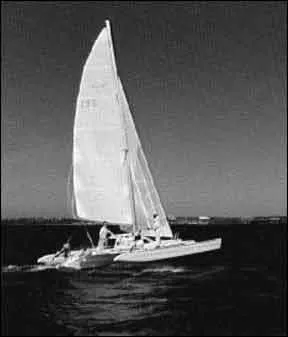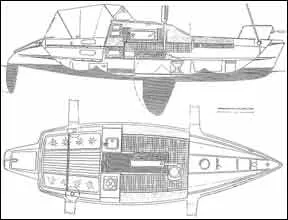At the 1992 U.S. Sailboat Show in Annapolis, Maryland, there were more than a dozen multihulls on exhibit. How times have changed; just a few years before, bitter from lack of interest by the boating public, multihull builders and designers seemed to be saying, “If you ain’t gonna buy me, then I ain’t available…it ain’t me you’re looking for, babe!” Scorned, they pretty much kept to themselves.

But many multihullers persisted. And the record times of the big cats and tris in long-distance singleand double-handed events were too spectacular to go unnoticed. We’ll never forget motoring out in a Mako photo boat to meet Chay Blyth and Rob James finishing the Two-Star off Newport, Rhode Island. His Brittany Ferries GB had made landfall off Cape Cod, then turned southwest toward Newport. We came upon him just as the sun set, making 20 knots in a rainbow of spume. It was hard to keep up, even with a Chrysler 318 V-8 under the saddle.
Over the years we’ve had a number of unforgettable experiences aboard multihulls—skimming across Saginaw Bay with Meade Gougeon aboard his 35-foot Adagio, sailing close-hauled downwind; cruising the Chesapeake aboard a Gemini catamaran, the only boat our son with cerebral palsy ever felt really comfortable on; and ripping up Buzzard’s Bay on Chris White’s Atlantic 50 cat, everything wire taut, slicing the chop as neatly as a Veg-A-Matic.
You’ll never be converted from a monohull to a multihull without first taking a ride. What gets you is this: 1. In light air, when you would be motoring your monohull, you can make six knots, and in higher wind speeds you double or triple your speed. A good multihull does to ocean passages what the Concorde does to air time between Paris and New York. 2. No heel. You begin to realize that much of the fatigue you’ve experienced in the past comes from sailing on your ear, every muscle tensed. 3. The multihull is a vast platform offering new freedom, new vistas, and, for the slightly misanthropic, new opportunities to get away from the rest of the crew. Multihulls have arrived, folks. And so has the Dragonfly 800 Swing Wing.
The Design and Construction
The Dragonfly 800 comes in two configurations, one for racing and one for what the company calls cruising, which is a misnomer only in that it implies a plodding demeanor, which is hardly the case. The essential difference is a taller mast and Kevlar sails for the racing model. Our test sail was aboard the “cruiser.”
The designer of the Dragonfly is Borge Quorning, a Dane who also builds them. The first boat was launched in 1981; the 800 Swing Wing is a third generation model, introduced in 1989.
Construction is unidirectional fiberglass with Airex coring in the hull and deck. The glass work looks first-class with no ripples, clean edges, and many nice details such as a comfortable angle for the cockpit coaming/backrest. Most of the hardware is of good quality, including Frederiksen blocks and Andersen winches. An alleged bad batch of resin caused delamination of several rudders a couple of years ago, but, according to the importer, the problem has been rectified.

To retract its amas for berthing or trailering, the Dragonfly 800 incorporates a different method than the F-27, to which it is often compared. Whereas the F-27’s crossbeams pull up and in, the Dragonfly’s pivot aft. The advantage is that it’s extremely easy to pull in an ama: Remove the aluminum strut between the hull and crossbeam, ease tension on the rig, loosen the netting and winch it in. The down side is that with both amas drawn in, the boat’s beam is just over nine feet, which is wider than the legal road limit. For trailering, four bolts on each ama must be unscrewed and the ama removed. They stow upside down on the trailer. This isn’t a big deal, but it does take a little longer than commissioning or decommissioning the F-27.
Clearly the rigging of the Dragonfly has been refined over the years as everything is very well thought out. All sail handling operations can be accomplished from the cockpit. For example, the drum of the roller furling gear is located below the deck (at the forward end of the anchor locker), and its control line is led aft to emerge underneath the traveler in the cockpit. Lines to haul the amas in and out emerge from seemingly nowhere on top of the cockpit coaming, right next to a winch. Very convenient.
And a barberhauling system, led from the bow of each ama to blocks on the jib sheet, then to the aft end of each ama and into the cockpit, permit infinite and precise sheeting. The rotating mast also can be controlled from the cockpit. Most controls run through rope clutches on the coachroof.
Performance
We test sailed the Dragonfly 800 on Long Island Sound, on a chilly but sunny day in October. Winds were light—5 to 8 knots. Reaching we were able to sail at the speed of the wind, and nearly so upwind. We were reminded that in a monohull we’d probably be motoring.
Top speed, according to company literature, is about 25 knots, which would have to be one hell of an experience. Above 12 knots, we were told, you get a beautiful roostertail.
The boat tacks easily, pivoting about its centerboard. There is little if any helm, at least at slower speeds, and with the main and jib sheeted in for most points of sail, you feel like you’re driving a go-cart in an empty mall parking lot—just aim and go.

Dragonfly 800 Diagram
Broad reaching we set the spinnaker, which on a multihull is easy because no pole is necessary. And with each clew sheeted to an ama, there is no fear of it wrapping the forestay.
An interesting characteristic of the Dragonfly is that when overpowered, the hull begins to lift and the rudder cavitates, causing the boat to round up. We’re not sure we’d rely on this as our only clue to possible danger, but it’s nice to know that the boat’s natural inclination is to round up rather than flip.
The recommended outboard size is 6 hp., which will move the Dragonfly in flat water at 7.2 knots. It can be controlled from the cockpit, allowing you to turn both the motor and the tiller at the same time, in which case it will do donuts in its own length.
Interior
We’ve grown accustomed to the fact that small trimarans don’t have the interior volume of a similar monohull. That said, we found the Dragonfly’s accommodations cheerful and tastefully done.
The V-berths are quite long (about 7 feet), with a tinted skylight overhead. You can’t sit up in bed, but there’s ample leg room. A pull-down privacy blind separates the V-berths from the settees. An optional toilet may be installed under one cushion.
The settees in the main cabin have fold-out panels underneath the cushions that secure against the centerboard trunk; the backrest cushions then fit over the panels and presto, you’ve got two 30-inchwide bunks. Fitted over the centerboard trunk is a teak drop-leaf table. Aft is a small split galley with sink (17-gallon water tank) and single-burner Origo alcohol stove. We did note that the seacocks did nothave flanges, which are recommended by ABYC.
With ash plywood overhead, designer lights, teak trim, and a nice view out the windows from a seated position, time spent belowdecks is pleasant and comfortable. Especially appreciated is the forward facing hatch, which allows a good deal of light and air into the cabin.
The cockpit can become an extension of the living space with the dodger and Bimini erected and zipped together. Both fold unobtrusively out of the way and are further illustrations of how everything on this boat fits together just so.
Conclusion
For us, buying a Dragonfly would be like buying a Porsche, a strong move that puts you back in touch with the road. Though company literature states that boats may be custom equipped at the factory for transoceanic passages, we would not attempt it. In fact, we like this boat better without confusing its purpose. To our mind it’s a terrific daysailer and an adequate coastal cruiser.
Choosing between the Dragonfly 800 and F-27 is tough. With a 1993 base price of $49,500, the Dragonfly is about the same as an F-27, but includes many standard items that are optional on the F-27, such as sails and roller furling. It’s also a foot shorter and does not have the F-27’s aft cabin with extra berths. Frankly, we like the looks of the Dragonfly’s open transom better, as well as the convenience it affords swimmers. On the other hand, the F-27’s aft cabin gives some folks an added sense of security in the cockpit. Which you favor may depend on whether you need those extra berths. As far as main cabins go, we favor the Dragonfly’s.
Our final impression of the Dragonfly 800 is that it’s just plain fun to sail. We like it.
































Hi! Darrell, I’ve recently acquired a damaged Dragonfly trimaran 8M, and while I love the tri with lots of multi experience, I’ve fallen into a rut and need some help. I’ve searched the web for info on the ‘folding system’ and can only find a different model to mine, (Canadian model) with ‘balsa core’. The system I did find has ‘folding ropes’ coming from ‘inside’ the beams and mine doesn’t. any help from you or your readers would be greatly appreciated. Also to help motivation, (as I get older), I’d like to acquire a MODEL of an 8 or 9.2M MODEL of the tri., I’m quite happy to beg, borrow (with deposit) or buy it if available. I appreciate the great work you do, and Thank You very much, ‘B J’.